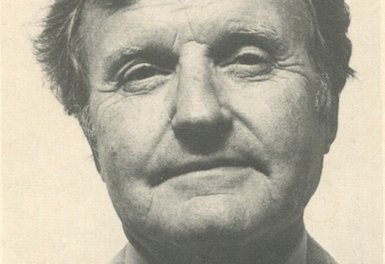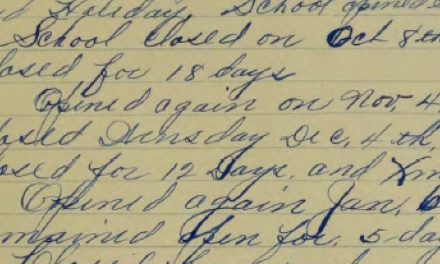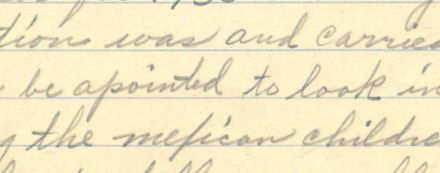During the spring of 1954, the polio vaccine was released for children, Bill Haley and his Comets released “Rock Around the Clock,” and Civil Rights leaders were celebrating the Supreme Court’s decision in Brown v. Board of Education of Topeka when Justices ruled unanimously that racial segregation of children in public schools was unconstitutional.
Back in Round Rock, Texas however, the outlook wasn’t so optimistic.
“Ominous clouds were on the horizon to the west from Hutto,” noted Noel Grisham in his 1974 autobiography, Beyond the Schoolhouse: Then and Now. “The Round Rock superintendent had decided in 1954 that he would improve the Round Rock schools and prepare for some anticipated growth,” explained Grisham.1
“Coach Perry:” coach, teacher, principal, superintendent
Oliver F. (O.F.) Perry had been employed by Round Rock ISD for almost 30 years beginning as a well respected coach then principal of Round Rock High School. Perry served the Round Rock Independent School District during a formative period from 1939 to 1957. He established a policy of bringing students from around the district to a central high school so that there would be enough students to offer advanced classes, sports, and extracurricular activities. While many teachers were in the services during WWII, he coached several boys and girls sports teams. “Coach Perry” is remembered for the energy he devoted to the mentoring and character development of his students and players.
“As long as he maintained the long-standing traditions, sought no improvements or changes, kept taxes at the low level or twenty-year fixed pattern,” Grisham noted, “all was well.”2
O.F. Perry knew this long standing fiscally conservative approach expected by local taxpayers would not meet the current classroom shortage and academic needs that he sought to improve. And it certainly did not address the need to adhere to the Supreme Court’s recent ruling regarding the unlawful practice of segregation of students in the District’s schools. Compliance with the Court’s decision would not be addressed by the Round Rock ISD Board of Trustees for another decade.
An eye for the future: building program initiated
The trouble seemed to begin on February 8, 1954, when a general meeting was called by President Rev. Theodore Krienke. Krienke was employed as the superintendent of the Lutheran Aid and Orphan Society and was serving his 22nd, and final year as a Trustee. Krienke was appointed to the school board on May 3, 1932 and was chosen to serve as its President on November 1, 1932. He was elected President of the School Board by his peers each year thereafter. Minutes of the March meeting indicate that a request to survey the community to determine what steps were to be taken by Superintendent Perry toward a future building program for Round Rock.
The District was in need of a new elementary school, specifically, a five classroom building to “help in the present crowded conditions partially caused by the students from the Texas Baptist Children’s Home,”3 explained Grisham.
A May 15, 1954 Bond Election in the amount of $200,000 passed and on May 22, the Board approved a motion to hire an assessor for a “reappraisal of real estate and certain personal properties in the School District.”
Higher taxes from the reappraisal, along with details of Superintendent Perry’s building program, was met with resistance from community members who were opposed to higher taxes. Grisham recalls that the, “bond issue set in motion a sizeable revolution. The larger question of whether or not the nations of the world could coexist gave way to the more immediate speculation as to whether or not the people in Round Rock could coexist.4 (Note: the Board Minutes do not outline or mention specifics of the Perry’s School Building Program other than providing additional classroom space).
The resistance to change begins
The August 27, 1954 Board Minutes state, “a meeting was held to hear a group of citizens, namely, Luther (L.O.) Ramsey, Moody Mayfield, John Robertson, Harry Robertson, Ray Glenn and Edward John (E.J.) Walsh. Jr. These gentlemen were present for the purpose of voicing opposition to the District’s School Building Program. They stated that they had been appointed by a large group of citizens who opposed the project.” During the meeting, they laid out 15 points of disagreement.
Mr. Luther Ramsey served as chief spokesman and listed several points that were causing disagreement. Points listed for the Board’s consideration were:
1. The Tax needed will create to[sic] great a hardship on the community.
2. There is too much misunderstanding.
3. The District is not able to plan for the future but rather must confine plans to immediate future.
4. District is in debt now.
5 . Opposed to receiving transfers from other Districts.
6. Site of proposed building is unpractical [sic].
7. City will be unable to provide water and sewer connections.
8. Should build only the class rooms needed.
9. Should acquire property adjacent to present School Buildings.
10. Round Rock cannot afford a complete modern new Elementary School Building.
11. Do not expect the school attendance to increase sufficiently so that a completely new building will be needed.
12. Do not desire to consolidate with other districts if consolidation would require more classrooms.
13. Too much attention is paid by the Board to State requirements for recomendations [sic] for school sited, and enrichment features of the educational program that this district can not afford.
14. The Superintendent, is to [sic] aggresive [sic], wants a stronger program than the community can afford, and dominated the action of the Board.
15. School Board is not exactly competent enough to direct the school program.
Nonetheless, on March 1, 1955, Trustees moved forward with the superintendent’s building plan and voted to allow transfers from other districts. Northside Elementary School near the Texas Baptist Children’s Home opened on March 21, 1955. Local businessman Louis Henna and the Baptists built and donated a school building to the school district.5
As a result, farmers and ranchers led the assault as their lands were assigned higher values. The tax equalization board members were forced to close their scratch tablets and find security back at their homes. The school board was categorically retired as fast as the elections came up.6
Board elections spark consequences
Changes within the Board of Trustees to undo Perry’s plan were swift. L.O. Ramsey and Pete Hester were elected to the Board of Trustees a month after Northside Elementary opened – in April 1955, replacing Douglas Morris and Rev. Theo Krienke. – Krienke had resigned on April 6, 1954 and his absence on the Board opened the door for another dominant personality to take the reigns. Luther Ramsey appeared to be up for the task. Grisham described Ramsey as “dominant and outspoken.”7
During the August 2, 1955, Board of Trustees meeting, L.O. Ramsey made “a motion to look with favor upon the petition from tax payers to cancel bonds voted by District in May 1954.” The motion received a unanimous vote.
On Sept. 6, 1955 a petition was presented to the Board by 22 qualified tax paying voters asking that an election be ordered for the purpose of cancelling the $200,000.00 in bonds voted in May 1954. A motion to order an election for the cancelling of said bonds was made and seconded by newly elected members L.O. Ramsey and Pete (J. P.) Hester. The motion was carried by unanimous vote.
Incorporated in this resolution were the following items.
1. That an explanation of the new Bond Tax Law Senate Bill 116, 54th Legislature be made showing how the District can save money by revoking bonds needed under this new Law.
2. That the people of the district be made aware of the fact that new class rooms are going to be needed soon to take care of our children.
Now that the 1954 Bond was cancelled, the superintendent’s contract was next. On October 4, 1955, a motion was made by Hester and seconded by Ramsey that all the principals and the superintendent be offered a one year contract. Hester and Ramsey voted yes and four voted no. Motion defeated.
A motion was made by S.C. Inman and seconded by Billy Sellstrom that the Board offer principals and the superintendent a two year contract with the years covered by this motion are as follows: July 1, 1956 to June 30, 1958. Four voted yes and Hester and Ramsey voted no, motion carried. It appeared that Superintendent Perry’s contract was secured for two more years.
However, in April 1956, Trustee Joe Cariker was voted out of office in favor of Harry Robertson. and L.O. Ramsey was elected President of the Board of Trustees.
On January 11, 1957 a Special Meeting of the Board of Trustees was held. Mr. Ramsey stated that the purpose of the meeting was to try to bring about harmony and cooperation in our school system.
A new Board of Trustees takes charge
A Trustee Election held Saturday, April 6, 1957. Three newcomers – Mrs. Duwaine (Neysa) Callison, Ernest N. Johnson, and Moody G. Mayfield won resounding victories over the following Trustee members seeking re-election: Billy Sellstrom, Theo. Zimmerman and Clarence Quick.
The Board of Trustees in 1957 now included L.O. Ramsey, Perry “Moody” Mayfield and Harry Robertson, three of the citizens who led the opposition to the District’s School Building Program August 1954. Furthermore, not a single Trustee who served during the 1954 Bond and voted for Perry’s District School Building Program remained on the dais. All members of the 1954 Board had been replaced.
Superintendent Perry’s superintendency appeared to be in serious jeopardy.
“With the tax board and school board liquidated and expended, the superintendent was next in line.”8 Grisham mentioned that the “political-social climate and school community was about as stable in Round Rock as conditions were described in Shakespeare’s Julius Caesar.9
The August 27, 1957 Board of Trustees Minutes includes a handwritten amendment to the Minutes as follows:
“Amendment: The minutes of a Called Meeting of the Board of Trustees on August 28th, 1957 were amended as follows: President Ramsey asked Mr. Perry for his resignation on grounds of neglect of duty. Mr. Perry stated that he would resign and have a written statement of resignation the following day, August 29th, 1957. Mr. Perry turned over the key of the school to the school board at that time.”
The next day, another Called Meeting was held. The Minutes were amended as follows:
“Amendment: The Minutes of the Board Meeting on August 29th, 1957 were ammended [sic] by inserting the word written – ammended [sic] to read as follows: at the Called Board Meeting of August 28, Mr. Perry assured the Board that he would have a written resignation on the morning of August 29th. Another meeting was called for the nite [sic] of August 29th. At this time the Board had not received a written resignation and Mr. Perry was not present at this meeting.”
That’s a mighty rough place over there
Just two days later – on the last Saturday afternoon in August 1957, all seven members of the Round Rock ISD Board of Trustees9 made the nine mile journey east to Hutto. Their mission was to offer Noel Grisham the superintendency job. Grisham at the time was serving as the superintendent of Hutto ISD and was quite content in his role.
Grisham later recalled a Hutto ISD Trustee member had warned him about the citizens of Round Rock. “Mr. Grisham, you don’t want to leave here and go over to Round Rock. That’s a mighty rough place over there. Those people play rough. Talk to anybody in Taylor or Georgetown or anywhere else in the county about Round Rock. They’ll tell you it’s difficult there.” Grisham knew the challenges that lay ahead if he took the job, noting that, “people around Williamson County had admitted that if a man was unable to believe in either heaven or hell, he should move to Round Rock. There, they said, one could find some of both and plenty of the latter.”10
But Grisham felt that he was up for a larger challenge11 and on September 4, 1957, just seven days after O.F. Perry was asked to resign as superintendent, the Board of Trustees awarded Grisham a two year superintendent contract.
After Perry and his wife left Round Rock, the intimidation tactics remained, cites Grisham. “Mr. Perry’s relentless foes had continued their battle against him even after his resignation. They had written letters to newspapers from Austin to Waco making charges and asking insinuating questions.”12 Perry had called upon the state commissioner to have the Round Rock Board compensate him for the final year of his contract – which ended June 30, 1958. Battle stations were taking shape for the final fight in a psychological war that had been building up for three years. “The board set in motion very quickly their counter attack – not the real cause of the long-standing furor which was the tax raise.” Their reason, according to Grisham, “the superintendent had failed to change completely some school practices which had been legislated eight years earlier in 1949.”13
Grisham noted that the educational process in Round Rock “continued under great financial strain” after Perry resigned.14 “Unpaid notes, overdrafts and unpaid bills, accumulated because of very inadequate local taxes posed a part of the multi-faceted challenge.”
Ironically, these were the very issues Superintendent Perry foresaw and addressed with the 1954 Bond and his District Building Plan, only to see it and his superintendency negated by Board members who were opposed to higher school taxes.
Note: Two of O.F. Perry’s granddaughters contributed the following account of the events as told to them by their grandmother.
The man who mowed the school yards failed to finish one small portion due to it being dark and there were no lights. This is what they used against my grandfather stating he didn’t fulfill his duties.
There were threats on my grandfather’s life and Mr. Grisham the next superintendent, and his wife sat in their car at the end of my grandparent’s driveway into the night one night protecting them, we believe. Someone hung my grandmother’s cat Coco from a tree in front of her kitchen window for her to see the next morning.
My grandparents were fine Christian people and were loved in their community.
My grandfather, O.F. Perry (Oliver Floyd Perry) was the Superintendent of the Round Rock Schools from 1939-1957. He was very influential in encouraging families in surrounding small communities to enroll in the RR schools so that college preparatory classes could be offered and better extracurricular activities. Our family is aware that after the Brown v School Board Supreme Court ruling of 1954 and the original desegregation plan to be completed in a 3 year plan by 1957, Mr. Perry took it seriously and presented the plan to the School Board during that time. I was a child, but I remember that he told me about the Black children attending a different school and using the old worn books,school materials and equipment from the school that the White children attended. His exact words were not recorded in the School Board Minutes, but my Mother told us about the speeches that he prepared about the need for minority children to have equal learning opportunities. He was well respected and liked by most people up until that time, evidently. When he brought up the idea of integrating all children into the same schools, however, there were heated discussions about the detrimental effect it would have on their children. We know what was said, most of it not printable at the time. The Austin Schools evidently integrated in part in 1957, but on the first day of school, August 1957, a few RR school board members (we think it was only by one or 2 votes) told Mr. Perry that he was fired for no valid reason. He received threatening phone calls, they were told to leave town. The family cat was hung from a tree. Family friends parked cars in a 24 hour watch at their home until they could leave.
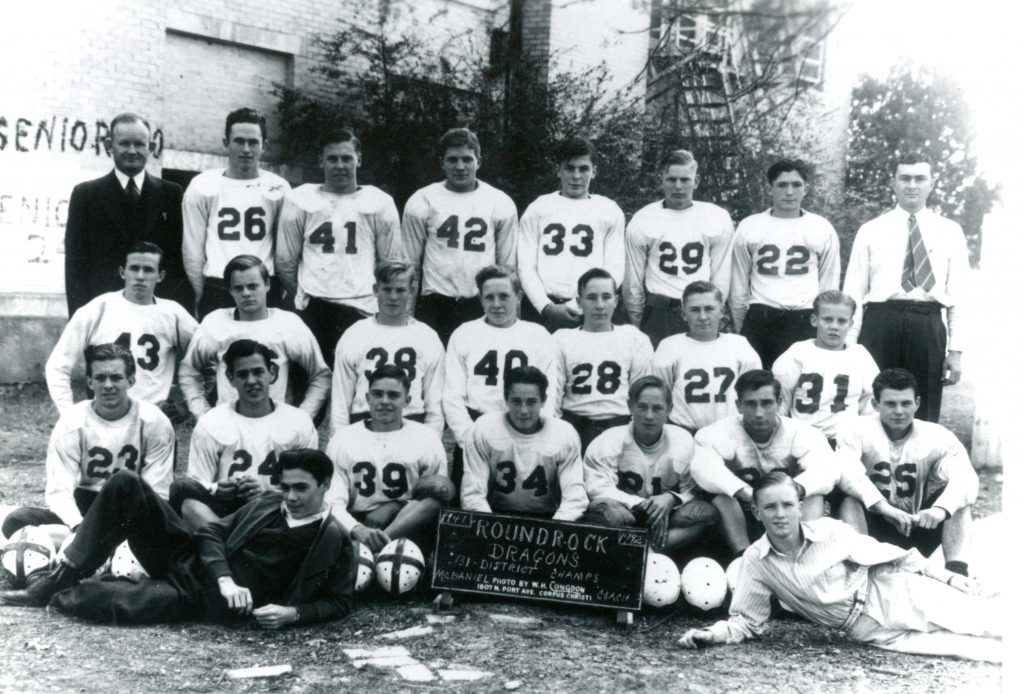
1941-42 Football team with Superintendent O.F. Perry (far left) and Principal O.V. McDaniel (right)
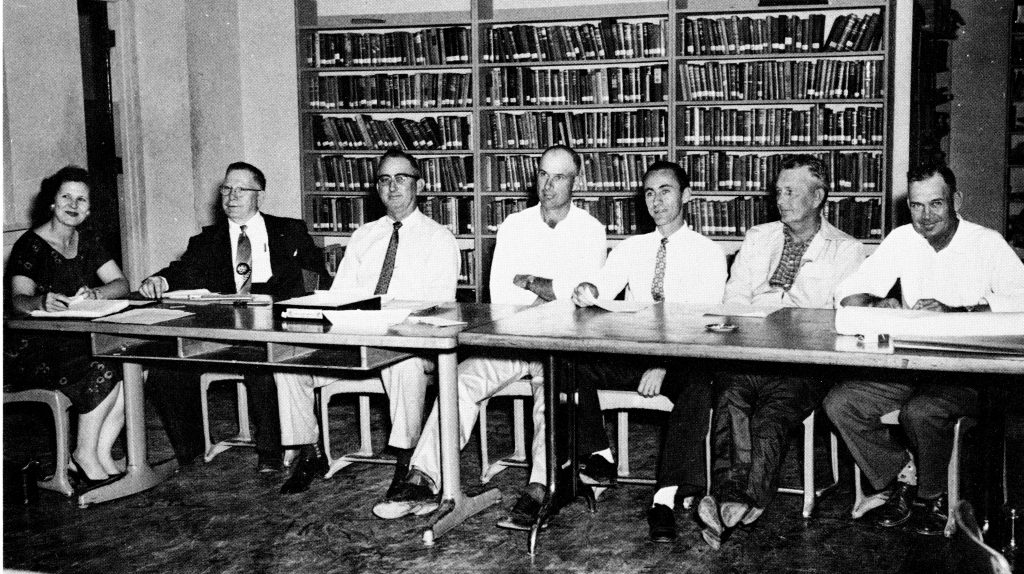
No photos of the 1957 Board of Trustees exist. The 1959 Board of Trustees shown in the photo included: Neysa Callison, Pres. Luther Ramsey, O. T. Bengstrom, Emmett Prinz, Harry Robertson, Moody Mayfield and Raymond Woytek.

1941-1942 District faculty. Front from left: Signe Quick, Unknown, Miss Halling (MS), Unknown, Milton Dusek (Music). Back row from left: Supt. O.F. Perry, Mr. McDaniel (HS), Norma Pfluger (MS), Elvira McKisick (ES), Mildred Thomas (HS), Susie Tyler, Unknown, Xenia Voigt (ES), Unknown Male.
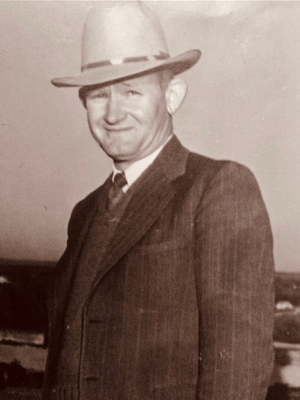
Superintendent O. F. Perry on top of the new High School around 1944. Courtesy of his granddaughter Dinah Daugherty.
1 Grisham, Noel. Beyond the Schoolhouse: Then and Now, Page 90.
2 Grisham, Noel. Beyond the Schoolhouse: Then and Now, Page 90.
3 Grisham, Noel. Beyond the Schoolhouse: Then and Now.
4 Grisham, Noel. Beyond the Schoolhouse: Then and Now, Page 90.
5 Grisham, Noel. Beyond the Schoolhouse: Then and Now, Page 90.
6 Grisham, Noel. Beyond the Schoolhouse: Then and Now, Page 90.
7 Grisham, Noel. Beyond the Schoolhouse: Then and Now, Page 91.
8 Grisham, Noel. Beyond the Schoolhouse: Then and Now, Page 91.
8 Grisham, Noel. Beyond the Schoolhouse: Then and Now, Page 92.
9 The seven members of the Board of Trustees were: President Mr. Luther (L.O.) Ramsey, Pete Hester, Harry Robertson, O.T. Bengstrom, Neysa Callison, Ernest Johnson and Moody Mayfield.
10 Grisham, Noel. Beyond the Schoolhouse: Then and Now, Page 92.
11 Grisham, Noel. Beyond the Schoolhouse: Then and Now, Page 92.
12 Grisham, Noel. Beyond the Schoolhouse: Then and Now, Page 93.
13 Grisham, Noel. Beyond the Schoolhouse: Then and Now, Page 92.
14 Grisham, Noel. Beyond the Schoolhouse: Then and Now, Page 93.


